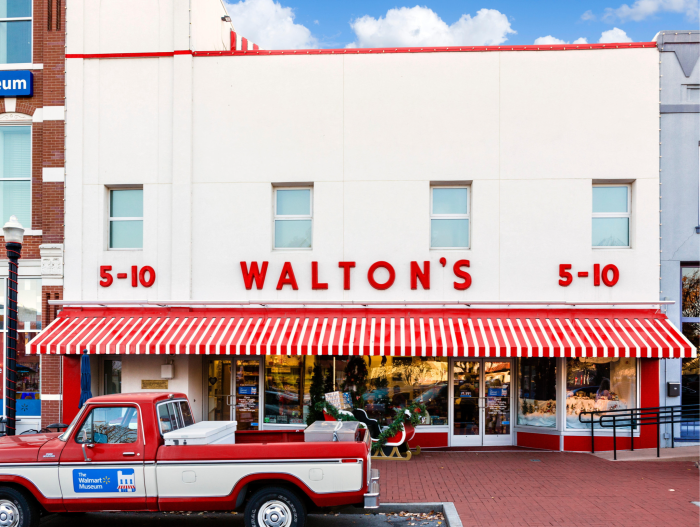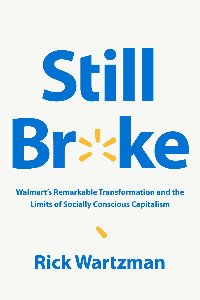Book review: Still Broke by Rick Wartzman

Roula Khalaf, Editor of the FT, selects her favourite stories in this weekly newsletter.
By the time Sam Walton opened his first Wal-mart in Rogers, Arkansas, in 1962, his playbook to build a global retail giant was already drafted. It centred on one key edict honed during his extensive prior experience in retailing: control costs.
Over the 60 years since, he and his successors have remained true to that principle as they have forged a company that has become, in the words of one commentator, “the most visited interior space on the planet”, hosting 220mn shoppers a week. It is the biggest employer in the US, with 1.5mn staff, and — among many other such records — the world’s largest seller of farmed salmon.
As Rick Wartzman describes in his nuanced Still Broke: Walmart’s Remarkable Transformation and the Limits of Socially Conscious Capitalism, Walton proved innovative in many ways: from placing popcorn machines on the pavements to lure customers inside, to introducing lightweight shopping baskets, self-service counters and cash registers from the off.
His legacy has spawned fiercely divided opinions, books, and even an off-Broadway musical. Walmart stores, which initially opened in towns of fewer than 25,000 inhabitants, have been praised for providing local employment and cheap, high-quality goods. At the same time, the company has been lambasted for its labour conditions and for destroying urban centres.
Walton and his successors adapted to the digital age and changing social values — in the process being first vilified and later praised by former US president Barack Obama. They were apparently largely driven by a view that such evolutions are also good for business.
They embraced green issues after Peter Seligmann, head of environmental group Conservation International, cunningly cultivated Rob Walton, Sam’s son who succeeded him as chairman. Seligmann took him on trips from Indonesia to Costa Rica to see the damage being wrought on marine and wildlife habitats.
Over the years, they also took steps to tackle a poor record on promotion of women, offered parental leave and training, and enhanced medical support for staff — and more affordable generic medicines for Walmart’s customers.
They also supported victims of Hurricane Katrina in 2005, opening warehouses, mobilising staff and distributing goods while the Federal Emergency Management Agency remained largely paralysed.
However, the retailer continues to be haunted by the fundamental issue of low pay. It long maintained a hostile attitude to unions, dismissing organisers and even crafting a “Working families for Walmart” organisation to counteract campaigners mobilising staff and public opinion as they sought recognition and improved benefits.
For four decades from 1971, Sam Walton practised a Faustian trade-off by naming his staff “associates” and maintained low wages in the short term while offering the potential of longer-term rewards for loyalty and collective success in the form of shares that crystallised on their retirement.

The company has since increased pay substantially above the modest US minimum wage. Yet 700,000 employees still earn less than $27,000 a year. In just six US states that collected the data in 2020, more than 10,000 were on Medicaid, the medical insurance system for those on low incomes. In nine states alone, more than 14,000 were on food stamps. There are multiple stories of staff unable to afford rent and sleeping between shifts in their cars.
Wartzman, a former journalist and head of the Drucker Institute (which received funding from the Walmart Foundation), does a good job summarising the company’s evolutions and tensions. He draws on more than 150 interviews and previous books and studies, although most of his quotes suggest a predominantly top-down approach of talking to company and union leaders.
There are few voices of the struggling employees. There is nothing on the wider implications of Walmart’s obsession with efficiency, such as the effects on farmers and other suppliers squeezed in the drive for higher margins by their oversized customer. Nor is there scrutiny of the wider environmental implications of pushing sales, even if wrapped in greener packaging.
The author could also have done more to explore the broader competitive context of retailing and how fair comparisons are with General Motors in the mid-20th century, which helped set a higher standard by investing in its labour force, in the process helping create a more prosperous middle class.
Wartzman strives to be balanced, even confessing “I have always been a both/and guy” in his hand-wringing conclusion. The result is that only in the final pages does he suggest that the prime responsibility in tackling low pay lies less with Walmart than with the government which should raise the minimum wage.
He is no doubt right on the need for tougher state intervention. But a business as large as Walmart will always struggle to escape responsibility for societal issues in the communities in which it operates, especially when driven by cost saving to maximise shareholder returns.
Still Broke: Walmart’s Remarkable Transformation and the Limits of Socially Conscious Capitalism by Rick Wartzman, PublicAffairs, £25/$29, 272 pages
This article is part of FT Wealth, a section providing in-depth coverage of philanthropy, entrepreneurs, family offices, as well as alternative and impact investment
Comments